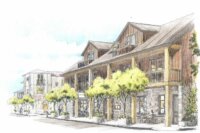A survey of 500 registered voters done early in April found that out of four options to replace the seismically non-compliant Sonoma Valley Hospital, respondents favored the “Broadway” and in-town options.
That was according to Charles Rund of Charlton Research Company who spoke Monday night to about 100 people at the Sonoma Community Center at a meeting of the Sonoma Valley Health Care Coalition.
Rund said that in the first round of questioning, respondents’ support for the proposed hospitals was as follows: 34 percent for the site at Broadway and Napa Road; 24 percent for an in-town hospital near the current Andrieux Street facility, 16 percent for the privately funded hospital on Eighth Street East and Napa Road proposed by Cirrus Health; and 14 percent for a 25-bed facility near the current hospital. Another 4 percent voted “none” and 8 percent “didn’t know.”
But after surveyors described the options in more detail, 62 percent of respondents liked the Broadway site, and 58 percent favored the in-town site.
Meanwhile, support for Cirrus only rose to 33 percent and the small hospital option only got 31 percent support.
The Sonoma Valley Health Care District would need approval from 67 percent of voters in order to pass a general-obligation bond to fund new hospital construction.
Surveyors also found that 62 percent of respondents were willing to pay taxes to support a new hospital, Rund said. The breakdown was: 5 percent were willing to pay between $0-$49 annually; 8 percent would pay between $50-$99; 9 percent would pay $100-$149; 14 percent, $150-$199; 9 percent, $200-$249; 3 percent, $250-$299; 14 percent, $300+; 20 percent said they didn’t know how much they’d pay.
Cirrus’ private hospital proposal fared best when surveyors asked which option respondents favored based on cost, garnering 29 percent support. But 42 percent of respondents said they disliked private ownership and felt that the hospital should be publicly owned. Rund discussed a separate survey of 35 Sonoma Valley physicians that found that 78 percent of them felt that the hospital should be not-for-profit.
Rund’s firm also surveyed non-physician hospital employees. And the coalition sent out 16,384 questionnaires to valley residents of which 3,875, or about 24 percent, were returned.
“In most direct mail (surveys), you’re doing well if you get 5 percent response,” coalition leader Steve Pease told the audience.
The coalition’s steering committee will weigh the survey results as it prepares its recommendation to the hospital board about which option to pursue; the coalition’s decision is expected soon.
• For more information about survey results, check the Sonoma Valley Health Care Coalition’s blog at http://svhcc.blogspot.com/




